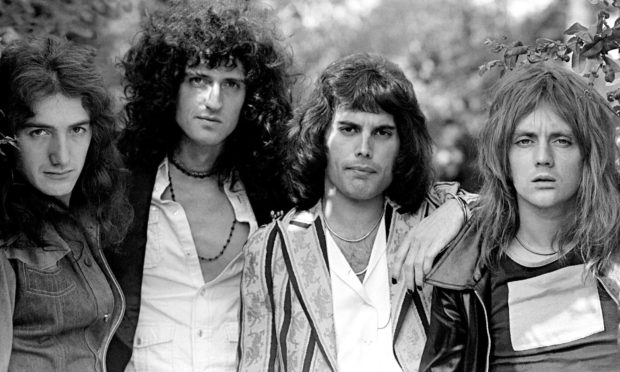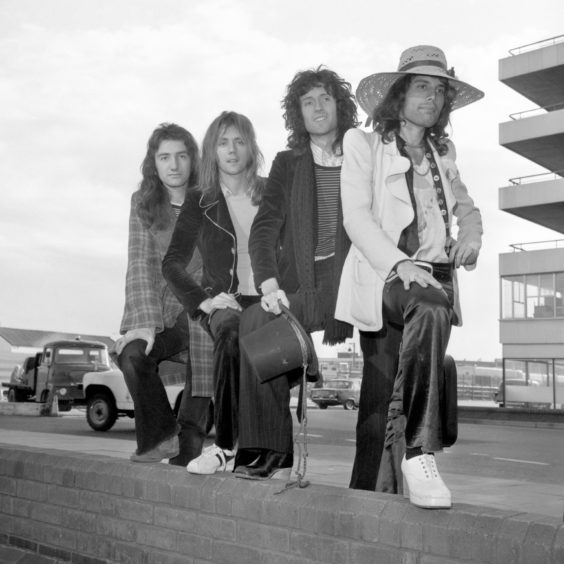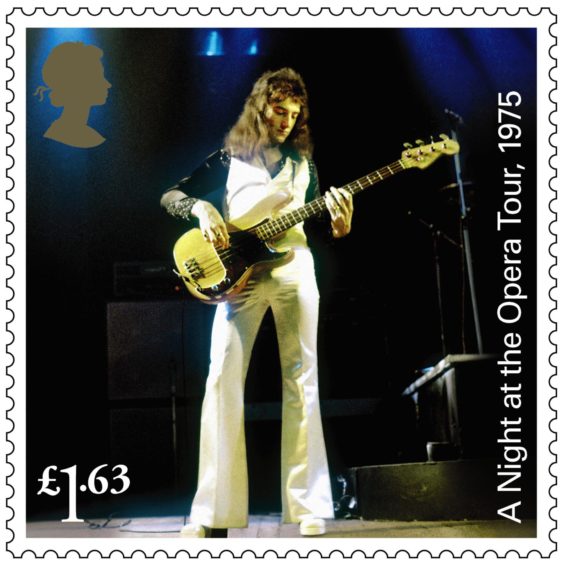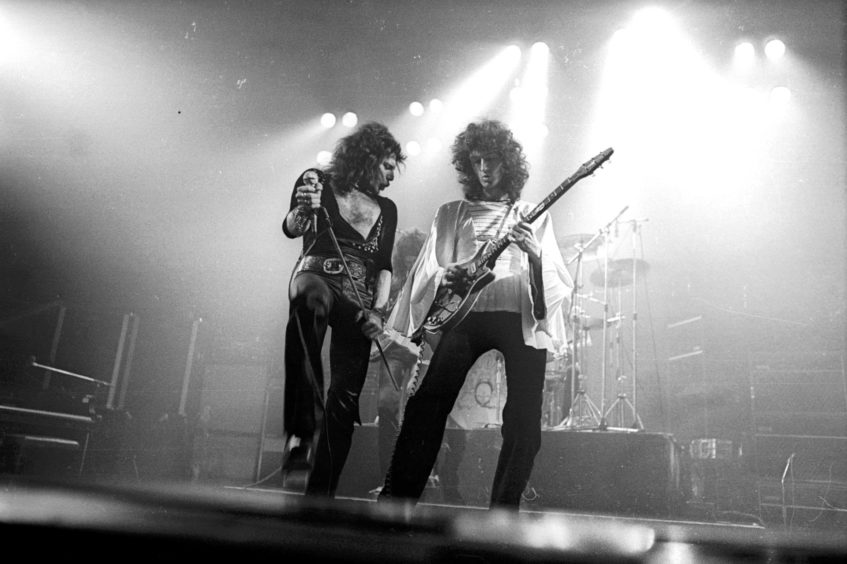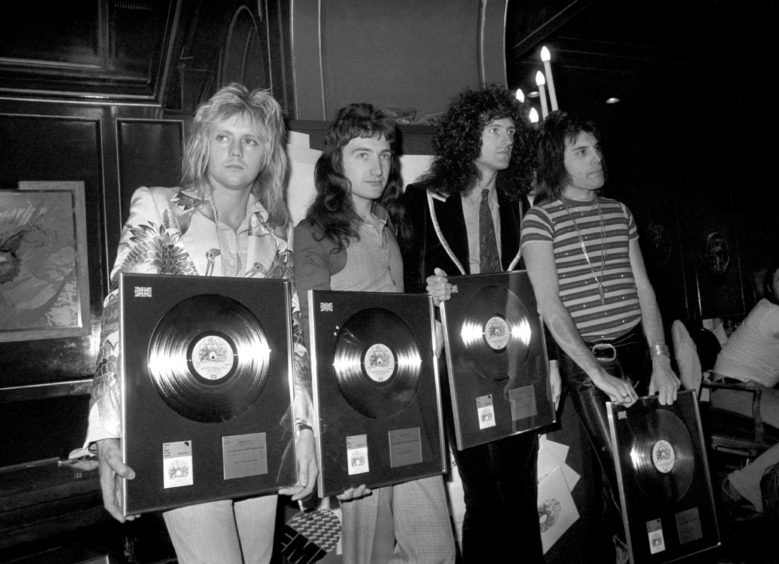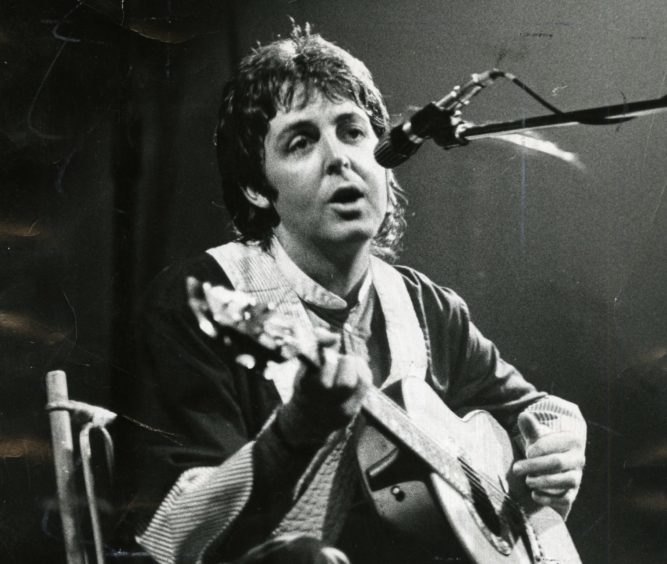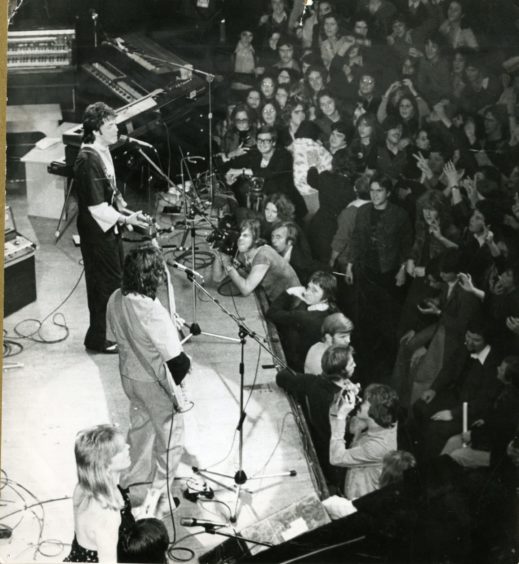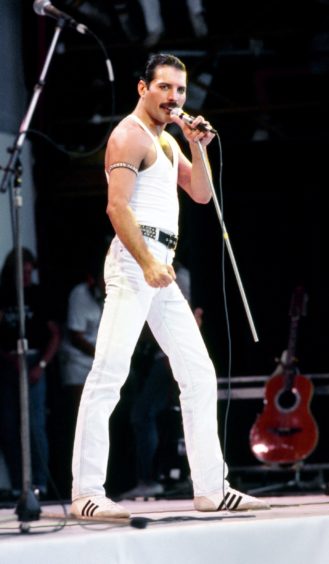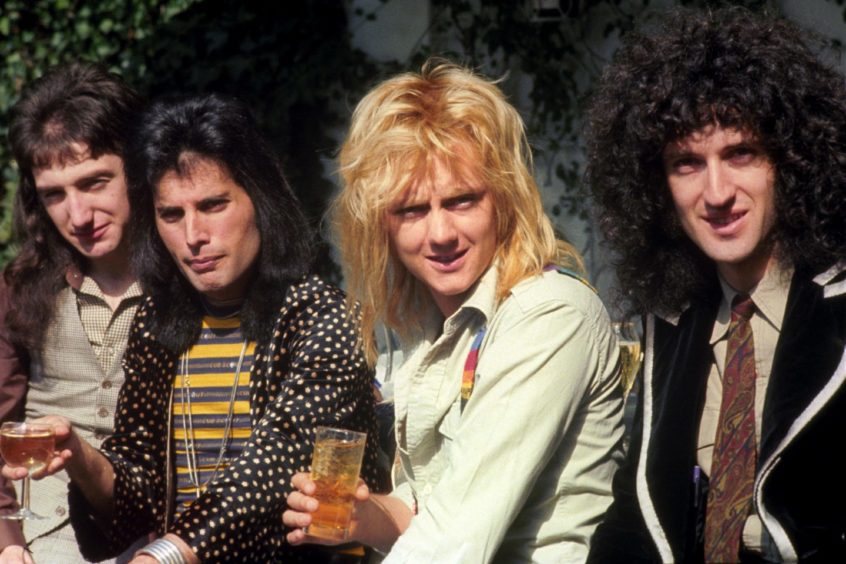Freddie Mercury tossed roses to his fans when Queen gave Dundee an unforgettable night at the opera.
Queen performed at the Caird Hall 45 years ago which coincided with Bohemian Rhapsody dominating the singles chart and the release of their fourth album which changed their lives and established the band as world superstars.
Tickets were £2 and £2.50 for the sold-out Dundee leg of Queen’s A Night at the Opera tour on December 13 1975.
Bohemian Rhapsody
The band were broke in 1974 after three albums when Elton John’s manager John Reid freed them of previous commitments to management and record labels and told them to “go away and make the best record you’ve ever made and I’ll sort out the money side”.
They produced a masterpiece although Reid didn’t think six-minute Bohemian Rhapsody was commercial enough as the lead single.
But the band ignored his advice and took the song to DJ Kenny Everett at Capitol Radio who was so impressed that he aired the song 14 times over one October weekend.
Hordes of fans then attempted to buy the single the following Monday and EMI eventually released it in its full-length glory.
It was perhaps fitting that the Dundee concert opened with a recorded introduction by Everett.
That was followed by the middle operatic sequence from Bohemian Rhapsody which blasted out while the band waited in the wings.
The famous guitar section from the song then kicked in which was the signal for Queen to burst on stage and kick off the show with live favourite Ogre Battle.
The band were soon feeding off the energy from the lively audience which was hanging on Freddie’s every word.
Bohemian Rhapsody was performed in full during the first half and set highlights included Killer Queen, Brighton Rock, Seven Seas Of Rhye and cover versions of Big Spender and Jailhouse Rock.
Freddie later threw long-stemmed red roses to his adoring fans as the concert finished with an instrumental version of the National Anthem.
Aspiring photographer
Ross Niven, 62, from Dundee, took photographs of artists and bands which performed at the Caird Hall from 1974-1980.
He described the Queen gig as a contender for the best gig he has ever seen at the venue.
Ross said: “My school friend Sam McMillan and I had an ‘arrangement’ with the Caird Hall management.
“We were aspiring photographers who were still at school and wanted to take photographs of bands at the Caird Hall.
“Somehow we talked our way into being given the job of taking photographs on behalf of the Caird Hall which meant that we got into the concerts free of charge and nearly always got to meet the performers.
“The exception to this was Elton John and, unfortunately, Queen.”
Ross became a fan of Queen after hearing the band’s self-titled debut album which was released in July 1973.
Tremendous showman
“The Caird Hall concert was the first time I had seen them live,” said Ross.
“In September that year, we attended a Bob Harris Old Grey Whistle Test Roadshow at the Dundee University student union and he played Bohemian Rhapsody to an astonished audience for the first time.
“Bohemian Rhapsody was at number one in the UK charts when the band performed in Dundee.
“It was one of the best and most well-received gigs I’ve ever seen.
“Freddie Mercury was a tremendous showman and performer.
“I have remained a fan ever since but the opportunity to see them again never arose.
“It has to be a contender for best ever gig at the Caird Hall in my time – and I saw quite a few.”
Drugs bust
In one last final twist, tour manager David Wernham was arrested in the Tay Hotel following the concert.
Police were called after the hotel’s assistant manager noticed a strange smell coming from Wernham’s room.
Cannabis was found in the toilet and Wernham told police he had no knowledge of how they had come to be there.
He went on trial at Dundee Sheriff Court and was found guilty in May 1976 of being in possession of cannabis and was fined £50.
Life through a lens: Ross once fell down at Paul McCartney’s feet on the Caird Hall steps
Some of the bands which performed at the Caird Hall during the 1970s included David Bowie, Led Zeppelin, Elton John and Rod Stewart.
The biggest name was Paul McCartney who performed during his post-Beatles career with Wings – just three months before the legendary Queen gig.
Ross was left looking like The Fool on the Hill when he fell down at McCartney’s feet after attempting to gatecrash the soundcheck.
Helping hand
“We had heard through the grapevine that security would be very tight for the Wings concert,” said Ross.
“Anyway, we decided to gatecrash the Wings soundcheck in the afternoon and I may have had to bunk off school for this!
“Mid-afternoon, we ran up the steps from Castle Street to the Caird Hall.
“To our astonishment, Paul and Linda McCartney were on the steps and there was no other person around – a photographer’s dream!
“Being young and foolish, I went charging towards this world famous couple at full speed!
“Just as I almost reached them, I slipped in a puddle and went up in the air and landed on my back.
“I can still hear Paul’s Liverpool tone saying, ‘are you all right mate?’, and offering a hand to get me to my feet.”
Ross was mortified and mumbled a grateful thanks to the music icon.
He then got their autographs but forgot to take their photograph.
To cap it all, Ross’s autograph book, which featured many famous names, then mysteriously disappeared.
Freddie Mercury: The Great Pretender
Born Farrokh Bulsara, in Zanzibar, on September 5 1946, he started going by the name of Freddie when he was at St Peter’s, a boarding school for boys near Mumbai.
He legally changed his name to Freddie Mercury around 1970, when Queen was formed.
Freddie’s talents as an entertainer were first recognised when he was still a pupil at St Peter’s.
The headteacher was aware of Freddie’s talents and wrote to the future star’s parents, suggesting that Freddie could benefit from a musical education if they were willing to pay the necessary extra fees.
Moved to England
From there, Freddie started to learn to play the piano, joined the school choir and had starring roles in various theatrical productions.
After his family moved to England, Freddie became friends with Tim Staffell who was in a band called Smile with none other than Brian May and Roger Taylor, paving the way to a future group for the new friends, although Freddie sang with the bands Ibex and Sour Milk Sea first.
Staffell left the band and it was after his departure that Freddie and bassist John Deacon joined and Smile were renamed Queen.
The rest is rock history.
Queen enjoyed phenomenal success, with Bohemian Rhapsody the only song ever to reach the top spot in the charts at Christmas twice.
Their phenomenal success continued around the globe throughout the 1980s which was highlighted in 1985 by their show-stealing and unforgettable performance on stage at Live Aid at Wembley Stadium.
Barcelona
His first major collaboration outside Queen was with Dave Clark for the recording of London’s West End musical Time, in 1986.
This was followed in 1987 when he recorded an album with Spanish opera giant Montserrat Caballé and the LP’s title song Barcelona went on to become an anthem for Caballé’s home city and the theme for the Olympics in 1992.
Freddie had earned himself a loyal army of fans, who’d become concerned for him after he had begun to look gaunt and generally unwell in the late 80s.
He announced on November 23 1991, that he was suffering from AIDS and, just a day later, passed away.
Although it is now no secret Freddie was gay, he did have a long-term girlfriend, Mary Austin, whom he cared for very deeply.
The Queen ballad Love Of My Life was written for her, in fact, and they were close even after they broke up — Freddie was the godfather to Mary’s son, and when Freddie died, he left Mary most of his money, his house and recording royalties.
At his request, she was to be the only one given access to his ashes, whose whereabouts he only wanted Mary to know.
The Show Must Go On
In the weeks before his death, though gravely ill, Freddie, who sang The Show Must Go On, would go into the band’s studio in Montreux, Switzerland when he felt capable.
The album, which includes Too Much Love Will Kill You, was pieced together from those last recordings.
The song Mother Love is the final vocal recording Mercury made.
After completing the penultimate verse, the exhausted singer said he “wasn’t feeling great” adding: “I will finish it when I come back, next time.”
However, he never made it back and May later recorded the final verse.
